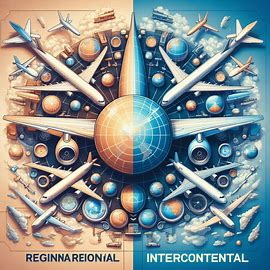
Introduction
In the world of aviation, aircraft are meticulously designed and regulated based on the intended operational scope. Two primary categories of commercial aircraft—regional and intercontinental—serve vastly different purposes and therefore have distinct design requirements, performance standards, and operational guidelines. Understanding these differences is crucial not only for manufacturers and airlines but also for regulatory bodies, pilots, and aviation enthusiasts. This comprehensive article explores the key differences between regional and intercontinental aircraft requirements, highlighting their design considerations, regulatory frameworks, operational capabilities, and economic impacts.
1. Overview of Regional and Intercontinental Aircraft
1.1 Definition and Scope
Regional Aircraft typically serve short to medium-haul routes, usually within a continent or country. These aircraft are designed to operate flights generally less than 1,500 nautical miles and accommodate fewer passengers, often ranging from 30 to 100 seats. Their primary role is to connect smaller cities to major hubs or facilitate short-distance travel efficiently.
Intercontinental Aircraft, on the other hand, are engineered for long-haul international flights crossing continents, often exceeding 3,500 nautical miles. These aircraft accommodate larger passenger capacities, typically over 200 seats, and are equipped to handle extended flight durations, requiring advanced fuel efficiency, comfort, and safety features.
1.2 Importance of Differentiation
Differentiating between regional and intercontinental aircraft requirements allows for optimization in design and operations, ensuring safety, efficiency, and passenger comfort tailored to the specific flight profiles. It also helps regulatory agencies develop appropriate certification standards and airlines to plan fleet composition strategically.
2. Design and Engineering Requirements
2.1 Aircraft Size and Capacity
One of the most apparent differences is the size and seating capacity. Regional aircraft prioritize flexibility and cost-efficiency on shorter routes. Their smaller size enables operations in airports with shorter runways and less ground infrastructure.
| Feature | Regional Aircraft | Intercontinental Aircraft |
|---|---|---|
| Typical Seating Capacity | 30–100 passengers | 200–400+ passengers |
| Aircraft Length | 25–35 meters | 50–80+ meters |
| Wingspan | Smaller, optimized for regional airports | Larger, optimized for high-altitude cruise |
2.2 Structural Design and Materials
Intercontinental aircraft demand robust structures due to longer flight durations, higher altitudes, and greater fuel loads. Advanced composite materials and aerodynamic designs are commonly used to reduce weight and improve fuel efficiency. Regional aircraft emphasize simplicity and cost-effectiveness, often using traditional materials and designs optimized for short takeoff and landing.
2.3 Engine Performance and Fuel Efficiency
Regional aircraft engines are typically turboprops or smaller turbofan engines optimized for frequent takeoffs and landings, lower cruising speeds, and shorter ranges. Intercontinental aircraft utilize high-bypass turbofan engines with superior fuel efficiency for long-range cruising at high altitudes, balancing thrust with extended engine life and lower emissions.
3. Operational and Performance Requirements
3.1 Range and Endurance
The range capability is a critical operational difference:
-
Regional Aircraft: Usually operate within 500 to 1,500 nautical miles, suitable for flights lasting 1 to 3 hours.
-
Intercontinental Aircraft: Designed for non-stop flights exceeding 6,000 nautical miles, capable of flying up to 15 hours or more without refueling.
This requires intercontinental aircraft to have larger fuel tanks and more sophisticated fuel management systems.
3.2 Airport Accessibility and Infrastructure
Regional aircraft can operate from smaller airports with shorter runways and limited ground support facilities, which increases their operational flexibility. Intercontinental aircraft require airports with longer runways, specialized ground services, and advanced navigation systems to support their size and operational complexity.
3.3 Flight Crew and Automation Systems
Long-haul flights necessitate enhanced cockpit automation, multi-crew operations with relief pilots, and advanced avionics systems to manage fatigue and maintain safety. Regional flights may operate with smaller crews and less complex automation due to shorter durations and less demanding flight environments.
4. Regulatory and Safety Requirements
4.1 Certification Standards
Both regional and intercontinental aircraft must comply with stringent aviation safety regulations. However, the standards differ:
-
Regional aircraft certification focuses on frequent cycle durability (takeoffs and landings), short-haul performance, and emergency evacuation under limited infrastructure conditions.
-
Intercontinental aircraft certification emphasizes extended operations, ETOPS (Extended-range Twin-engine Operational Performance Standards) compliance, and high-altitude safety features.
4.2 Environmental Regulations
Environmental impact regulations are increasingly stringent for both categories, but intercontinental aircraft face greater scrutiny due to their fuel consumption and emissions over long distances. Innovations in engine design and alternative fuels are more aggressively pursued in the intercontinental segment.
4.3 Noise and Emission Standards
Noise restrictions at airports heavily influence aircraft design. Regional aircraft, often flying into noise-sensitive smaller airports, must meet specific noise certification levels. Intercontinental aircraft face noise abatement procedures and emission limits, particularly on arrival and departure at major international hubs.
5. Economic and Market Considerations
5.1 Operating Costs
Regional aircraft are designed to minimize operating costs on frequent, short trips. Lower fuel consumption, reduced crew requirements, and simpler maintenance regimes contribute to cost efficiency.
Intercontinental aircraft incur higher operating costs due to fuel, maintenance complexity, crew size, and airport fees. However, their ability to transport large numbers of passengers on long routes helps airlines achieve economies of scale.
5.2 Fleet Utilization and Scheduling
Airlines use regional aircraft to feed traffic into hub airports, optimizing network connectivity. Intercontinental aircraft enable airlines to serve high-demand, long-distance markets, often as flagship routes.
5.3 Market Demand and Passenger Preferences
Passenger expectations differ by route type. Regional flights prioritize punctuality and frequency, while intercontinental flights emphasize comfort, in-flight services, and amenities. Aircraft design and airline service models reflect these preferences.
Conclusion
Understanding the differences between regional and intercontinental aircraft requirements reveals the complexity and specialization within the aviation industry. From design and engineering to operational, regulatory, and economic factors, each aircraft type is tailored to its unique mission profile. Whether it’s connecting smaller cities via regional jets or bridging continents with wide-body aircraft, these distinctions ensure safety, efficiency, and passenger satisfaction across the globe